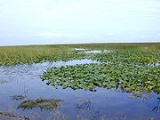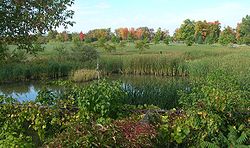
Marsh
Encyclopedia
- Marshland redirects here. For the suburb of Christchurch, New Zealand, see Marshland, New Zealand.

Geography
Geography is the science that studies the lands, features, inhabitants, and phenomena of Earth. A literal translation would be "to describe or write about the Earth". The first person to use the word "geography" was Eratosthenes...
, a marsh, or morass, is a type of wetland
Wetland
A wetland is an area of land whose soil is saturated with water either permanently or seasonally. Wetlands are categorised by their characteristic vegetation, which is adapted to these unique soil conditions....
that is subject to frequent or continuous flood. Typically the water is shallow and features grass
Poaceae
The Poaceae is a large and nearly ubiquitous family of flowering plants. Members of this family are commonly called grasses, although the term "grass" is also applied to plants that are not in the Poaceae lineage, including the rushes and sedges...
es, rush
Juncaceae
Juncaceae, the rush family, are a monocotyledonous family of flowering plants. There are eight genera and about 400 species. Members of the Juncaceae are slow-growing, rhizomatous, herbaceous plants, and they may superficially resemble grasses. They often grow on infertile soils in a wide range...
es, reeds
Phragmites
Phragmites, the Common reed, is a large perennial grass found in wetlands throughout temperate and tropical regions of the world. Phragmites australis is sometimes regarded as the sole species of the genus Phragmites, though some botanists divide Phragmites australis into three or four species...
, typha
Typha
Typha is a genus of about eleven species of monocotyledonous flowering plants in the family Typhaceae. The genus has a largely Northern Hemisphere distribution, but is essentially cosmopolitan, being found in a variety of wetland habitats...
s, sedge
Cyperales
Cyperales is a name for an order of flowering plants. As used in the Engler system and in the Wettstein system it consisted of only the single family...
s, other herbaceous
Herbaceous
A herbaceous plant is a plant that has leaves and stems that die down at the end of the growing season to the soil level. They have no persistent woody stem above ground...
plant
Plant
Plants are living organisms belonging to the kingdom Plantae. Precise definitions of the kingdom vary, but as the term is used here, plants include familiar organisms such as trees, flowers, herbs, bushes, grasses, vines, ferns, mosses, and green algae. The group is also called green plants or...
s, and moss
Moss
Mosses are small, soft plants that are typically 1–10 cm tall, though some species are much larger. They commonly grow close together in clumps or mats in damp or shady locations. They do not have flowers or seeds, and their simple leaves cover the thin wiry stems...
.
Woody plants will be low-growing shrubs. A marsh is different from a swamp
Swamp
A swamp is a wetland with some flooding of large areas of land by shallow bodies of water. A swamp generally has a large number of hammocks, or dry-land protrusions, covered by aquatic vegetation, or vegetation that tolerates periodical inundation. The two main types of swamp are "true" or swamp...
, which has a greater proportion of open water surface and may be deeper than a marsh. In North America, the term "swamp" is used for wetland dominated by trees rather than grasses.
Associations
Coastal marshes may be associated with estuariesEstuary
An estuary is a partly enclosed coastal body of water with one or more rivers or streams flowing into it, and with a free connection to the open sea....
, and are also found along waterways between coastal barrier island
Barrier island
Barrier islands, a coastal landform and a type of barrier system, are relatively narrow strips of sand that parallel the mainland coast. They usually occur in chains, consisting of anything from a few islands to more than a dozen...
s and the inner coast. The estuarine marsh, or tidal marsh
Tidal marsh
A tidal marsh is a type of marsh that is found along coasts and estuaries of which the flooding characteristics are determined by the tidal movement of the adjacent estuary, sea or ocean . According to the salinity of the flooding water, freshwater, brackish and saline tidal marshes are...
, is often based on soils consisting of sandy bottoms or bay mud
Bay mud
Bay mud consists of thick deposits of soft, unconsolidated silty clay, which is saturated with water; these soil layers are situated at the bottom of certain estuaries, which are normally in temperate regions that have experienced cyclical glacial cycles...
s. An example is the Tantramar Marsh of eastern Canada
Canada
Canada is a North American country consisting of ten provinces and three territories. Located in the northern part of the continent, it extends from the Atlantic Ocean in the east to the Pacific Ocean in the west, and northward into the Arctic Ocean...
.
Commercial application
Constructed wetlandConstructed wetland
A constructed wetland or wetpark is an artificial wetland, marsh or swamp created as a new or restored habitat for native and migratory wildlife, for anthropogenic discharge such as wastewater, stormwater runoff, or sewage treatment, for land reclamation after mining, refineries, or other...
s feature surface-flow design and are usually in the form of a marsh.
Related phenomena
Decomposition of plant materials below water often produces methaneMethane
Methane is a chemical compound with the chemical formula . It is the simplest alkane, the principal component of natural gas, and probably the most abundant organic compound on earth. The relative abundance of methane makes it an attractive fuel...
, which may begin to burn by self-ignition
Spontaneous combustion
Spontaneous combustion is the self-ignition of a mass, for example, a pile of oily rags. Allegedly, humans can also ignite and burn without an obvious cause; this phenomenon is known as spontaneous human combustion....
making mysterious lights known locally as will o' the wisp
Will o' the wisp
A will-o'-the-wisp or ignis fatuus , also called a "will-o'-wisp", "jack-o'-lantern" , "hinkypunk", "corpse candle", "ghost-light", "spook-light", "fairy light", "friar's lantern", "hobby lantern", "ghost orb", or simply "wisp", is a ghostly light or lights sometimes seen at night or twilight over...
s, jack-o'-lanterns, or sprites.
See also
- Aquatic plantAquatic plantAquatic plants are plants that have adapted to living in aquatic environments. They are also referred to as hydrophytes or aquatic macrophytes. These plants require special adaptations for living submerged in water, or at the water's surface. Aquatic plants can only grow in water or in soil that is...
- BayouBayouA bayou is an American term for a body of water typically found in flat, low-lying areas, and can refer either to an extremely slow-moving stream or river , or to a marshy lake or wetland. The name "bayou" can also refer to creeks that see level changes due to tides and hold brackish water which...
- Biodiversity Action PlanBiodiversity Action PlanA Biodiversity Action Plan is an internationally recognized program addressing threatened species and habitats and is designed to protect and restore biological systems. The original impetus for these plans derives from the 1992 Convention on Biological Diversity...
- BogBogA bog, quagmire or mire is a wetland that accumulates acidic peat, a deposit of dead plant material—often mosses or, in Arctic climates, lichens....
- FenFenA fen is a type of wetland fed by mineral-rich surface water or groundwater. Fens are characterised by their water chemistry, which is neutral or alkaline, with relatively high dissolved mineral levels but few other plant nutrients...
- Freshwater marshFreshwater marshA freshwater marsh is a marsh that contains fresh water. They are usually found near the mouths of rivers and are present in areas with low drainage. The Florida Everglades, the largest freshwater marsh in the United States, are an example of this type of marsh....
- Salt marshSalt marshA salt marsh is an environment in the upper coastal intertidal zone between land and salt water or brackish water, it is dominated by dense stands of halophytic plants such as herbs, grasses, or low shrubs. These plants are terrestrial in origin and are essential to the stability of the salt marsh...

